
South Africa is a culturally diverse nation with a wide range of experiences, from its three capital cities to its stunning national parks. For expatriates, the cost of living may appear manageable, but many South Africans face considerable financial challenges due to persistently high inflation rates. Data from 2024, however, suggests a potential reduction in inflation, particularly in essential expenses like groceries and other household necessities.
Key Takeaways
- Impact of High Inflation and Inequality on Grocery Costs: South Africa grapples with economic challenges, notably high inflation and income inequality. These factors drive up living costs, especially for essential expenses such as groceries and transport, which significantly impact much of the population.
- Urban vs. Rural Living Costs: Expenses differ markedly across regions. Urban centres like Cape Town and Johannesburg tend to have higher costs, particularly in housing and groceries, whereas smaller towns and rural areas generally provide more affordable options, making them more viable for individuals on stricter budgets.
- Shifts in Grocery Shopping Trends: Trends such as online grocery shopping, bulk-buying groups, and a focus on healthier options are influencing household grocery spending. While these trends can offer opportunities for savings, they may also bring challenges, such as higher upfront costs for bulk purchases.
About Arcadia Finance
Get your loan with ease through Arcadia Finance. We offer a hassle-free experience with no application fees and access to 19 trusted lenders, all regulated by South Africa’s National Credit Regulator. Discover reliable and efficient solutions, customized to your financial requirements.
What is the Current State of South Africa’s Economy?
South Africa’s economy is experiencing considerable challenges, with high inflation and extensive income inequality. While expatriates may find the cost of living relatively affordable compared to other OECD countries, income disparities remain pronounced, affecting cities and communities differently across the country.
According to the World Bank, South Africa ranks as the world’s most unequal country in terms of wealth distribution. Factors such as ethnicity, gender identity, and education level strongly influence poverty rates, with black South Africans and those lacking formal education facing the highest levels of poverty.
Salary inequality is evident in wage structures nationwide. Individuals in executive roles or specialised fields earn far more than most workers, and there is a significant pay gap between public and private sector employees. For instance, professionals such as teachers and police officers earn markedly less than those in corporate roles.
Poverty remains a critical issue, impacting over 60% of the population, who live below the upper-bound poverty line, set by the government at R1 558 ($90.10) per person per month as of 2023. Inflation from 2022 to 2023 worsened the situation, with steep rises in grocery and transport costs while wages lagged behind. This dynamic has led to a period of very slow economic growth, reflecting the broader issues facing South Africa’s economy.
Wondering how grocery expenses fit into the bigger picture? Understanding living costs in South Africa is crucial for setting realistic monthly budgets.
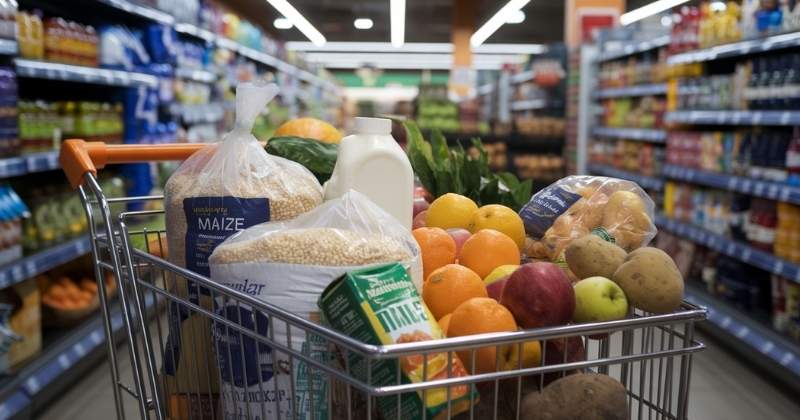
The Cost of Groceries in South Africa
The cost of groceries in South Africa varies considerably based on income levels and household requirements. According to the Bureau for Food and Agricultural Policy (BFAP), a “moderate-cost healthy food basket,” which includes staple items like grains, proteins, fruits, and vegetables, is estimated to cost around R5 277.30 ($305.18) per month.
Below is a summary of average prices for commonly purchased grocery items:
| Product | Price Range |
|---|---|
| Apples (1 kilo) | R15–36.00 |
| Bread (1 loaf) | R11.25–22.05 |
| Cheese (1 kilo) | R89–200.00 |
| Eggs (12) | R24–60.00 |
| Oranges (1 kilo) | R10–60.00 |
| Potatoes (1 kilo) | R10–40.00 |
| Regular milk (1 liter) | R14–29.00 |
| Rice (1 kilo) | R20–45.00 |
| Tomatoes (1 kilo) | R15–35.00 |
| Water (1.5 liters) | R12–23.00 |
Protein Costs
| Protein Source | Average Price (ZAR) | Quantity | Estimated Monthly Cost (ZAR) |
|---|---|---|---|
| Beef/Lamb | R80 – R150 per kg | 1 kg/week | R320 – R600 |
| Chicken | R40 – R60 per kg | 1 kg/week | R160 – R240 |
| Eggs | R20 – R30 per dozen | 1 dozen/week | R80 – R120 |
| Legumes (Beans/Lentils) | R15 – R40 per kg | 1 kg | R15 – R40 |
| Total (Estimated) | – | – | R400 – R1,000 |
Luxury or Occasional Items Cost Overview
| Luxury Item | Average Price (ZAR) | Quantity | Estimated Monthly Cost (ZAR) |
|---|---|---|---|
| Sweets/Chocolates | R10 – R30 per item | 5 items | R50 – R150 |
| Beer | R15 – R30 per bottle | 4 bottles | R60 – R120 |
| Wine | R50 – R150 per bottle | 2 bottles | R100 – R300 |
| Takeaway Meals | R50 – R150 per meal | 2 meals | R100 – R300 |
| Total (Estimated) | – | – | R200 – R1,000 |
Food Costs in South Africa
In South Africa, food expenses generally range from R2 000 to R4 000 ($104.94 to $209.88) per person each month, though costs vary depending on location, dietary choices, and shopping habits.
In Bloemfontein, a standard loaf of bread costs about R17 ($0.89), while dining out at a restaurant can range from R200 to R1 030 ($10.49 to $54.04) per meal. Cape Town, one of the country’s more expensive cities, has a slightly different pricing structure. A loaf of bread there is approximately R17.28 ($0.91), but restaurant meals are often less costly, averaging between R150 and R700 ($7.87 to $36.73) per meal.
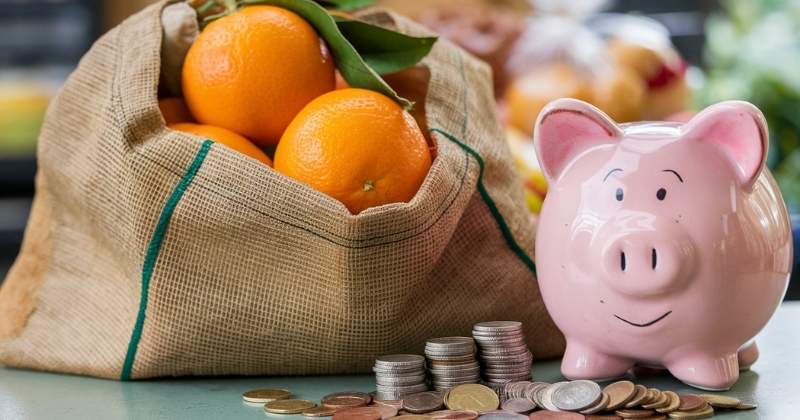
Impact of Dietary Choices on Grocery Spending
Dietary preferences can significantly affect monthly grocery expenses, with choices between plant-based and meat-based diets, as well as between processed and whole foods, influencing overall spending.
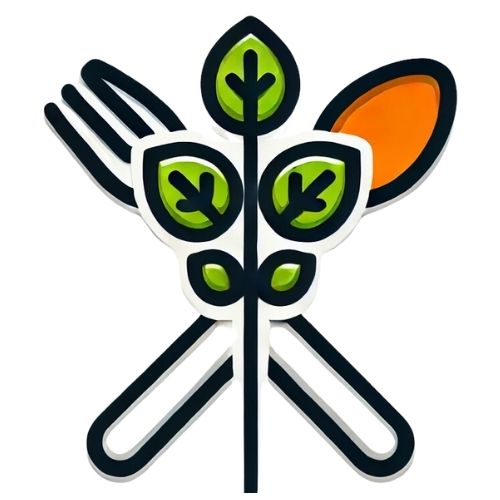
Cost Differences Between Plant-Based and Meat-Based Diets
Plant-based diets are generally more budget-friendly when based on staples like legumes, grains, and seasonal produce. However, costs can rise with specialised vegan items, such as plant-based meat alternatives or organic products. In comparison, meat-based diets are usually more expensive, particularly when including lean cuts, red meat, or seafood. Households that regularly consume meat may reduce costs by buying in bulk or opting for more affordable cuts but still often face higher expenses overall.

Processed Foods vs. Whole Foods
Processed foods, including ready-made meals and packaged snacks, tend to be more expensive than cooking from scratch with whole ingredients. While processed foods offer convenience, they are usually less economical and less nutritious. In contrast, whole foods like fresh fruits, vegetables, and grains are generally more affordable, especially when bought in bulk or seasonally. Although whole foods require more preparation, they are often a healthier and more cost-effective choice in the long run, as long as pricier items like nuts and seeds are managed carefully.
Adopting practical frugal living hacks can drastically reduce your monthly grocery bill. Discover smart tips on how to live well for less, from meal planning to strategic shopping.
Average Monthly Grocery Costs for Different Households
| Household Type | Average Monthly Grocery Cost (ZAR) | Key Considerations |
|---|---|---|
| Single Individuals | R1,500 – R3,000 | – Lower total grocery needs but potentially higher cost per person – Can save by cooking at home and purchasing basic staples – Costs vary based on dietary preferences (e.g., vegan, organic) and convenience food habits |
| Couples | R3,000 – R5,500 | – Ability to buy in bulk, lowering cost per person – Meal planning and shared cooking can further reduce expenses – Higher costs if preferring premium or specialty products |
| Families with Children | R6,000 – R10,000+ | – Need for diverse meal options, snacks, and school lunches – Costs increase with the number and age of children – Larger families benefit from bulk buying, but balancing affordability and nutrition can be challenging |
The rising cost of living is a direct reflection of the economic challenges facing South Africa. Read on how SA Faces Third Quarter Decline – we explore how inflation and financial strain are affecting household budgets, including everyday essentials like groceries.
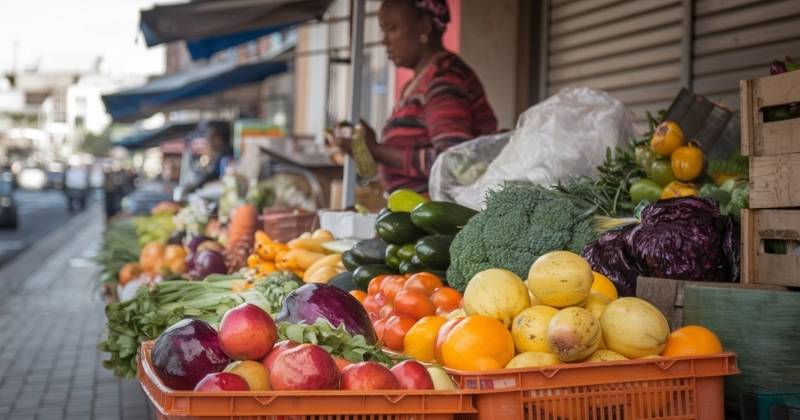
Healthy Eating on a Budget
Maintaining a balanced diet doesn’t have to strain your finances. By making thoughtful choices and using affordable, locally sourced ingredients, you can enjoy nutritious meals without overspending.
Here are some practical tips:
- Plan Your Meals
Creating a weekly meal plan helps you buy only what you need, reducing waste and unnecessary spending. Focus on recipes that use similar ingredients to make the most of your grocery list.
- Buy Seasonal Produce
Seasonal fruits and vegetables are often more affordable and fresher. For example, in summer, locally grown tomatoes, cucumbers, and berries are usually less expensive and more flavourful.
- Incorporate Plant-Based Proteins
Beans, lentils, and chickpeas are cost-effective sources of protein. They work well in various dishes, such as stews, salads, and curries, providing essential nutrients without the higher cost of meat.
- Cook in Bulk
Preparing meals in large quantities allows you to take advantage of bulk pricing and saves time. Dishes like soups, stews, and casseroles can be portioned and frozen for future meals.
- Use Affordable Staples
Staples like rice, maize meal, and pasta are versatile and budget-friendly. Pairing them with vegetables and proteins can create satisfying and nutritious meals.
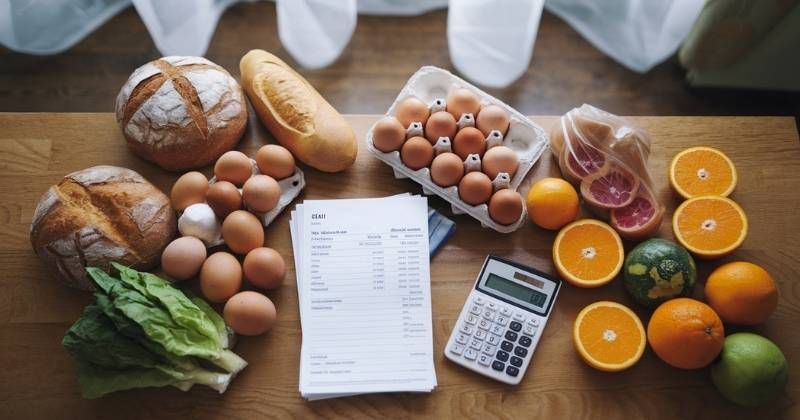
Grocery Shopping Trends in South Africa
Grocery shopping in South Africa is changing, influenced by technology and shifting consumer habits. Key trends include:
Increase in Online Grocery Shopping
The convenience of online shopping has led more consumers to buy groceries through digital platforms. Retailers like Checkers have expanded their on-demand delivery services to include general merchandise, aiming to reach a larger share of the e-commerce market.
Growth of Bulk-Buying Groups
Many consumers are joining or forming bulk-buying groups to purchase goods at discounted rates. This collective buying approach allows households to save on essentials by purchasing in larger quantities, thereby reducing per-unit costs.
Focus on Health and Wellness
With rising demand for healthier food options, retailers are increasingly stocking organic and health-focused products. This shift towards wellness is influencing both product variety and pricing.
Expansion into Underserved Markets
Brands like Tiger Brands are increasing their presence in South African townships, offering more stores carrying their products. This approach aims to make quality, affordable goods available to consumers in previously underserved areas, improving access and distribution.
Impact on Household Budgets
These trends present both advantages and challenges for consumers:
Healthier Options: Health-focused products meet the demand for wellness, though they may come at a higher price.
Convenience vs. Cost: Online shopping offers ease of access, though delivery fees can add to costs. Promotions and online-only discounts may, however, help balance these expenses.
Bulk-Buying Savings: Buying in bulk can result in significant savings, though it requires an upfront investment and enough storage space.
Conclusion
South Africa’s cost of living is shaped by economic challenges, regional disparities, and shifting consumer behaviours. Major cities offer greater convenience and job opportunities but come with higher costs, particularly for housing and groceries, compared to smaller towns and rural areas. High inflation and inequality affect the affordability of essentials, making budget-conscious strategies like meal planning, bulk buying, and loyalty programmes essential for managing household costs. As online grocery shopping and health-focused choices gain popularity, South Africans face both opportunities and challenges in adapting their spending habits for financial stability.
Frequently Asked Questions
The average monthly grocery cost ranges from R2,000 to R4,000 per person. A family of four typically spends around R5,277.30 for a moderate-cost food basket.
Yes, groceries are generally cheaper in rural areas due to lower overheads and proximity to farms. In contrast, cities often have higher prices because of transportation and operational costs.
To save on groceries, consider shopping at local markets, buying seasonal produce, purchasing in bulk, using supermarket loyalty programmes, and planning meals to reduce impulse buying.
Cape Town has the highest cost of living, with a family of four spending approximately R38,128.30 per month, excluding rent.
Online grocery shopping can be more affordable with exclusive discounts, but delivery fees might offset the savings unless purchases are well-planned.
Fast, uncomplicated, and trustworthy loan comparisons
At Arcadia Finance, you can compare loan offers from multiple lenders with no obligation and free of charge. Get a clear overview of your options and choose the best deal for you.
Fill out our form today to easily compare interest rates from 19 banks and find the right loan for you.


